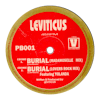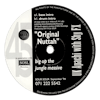Already a headlining DJ at the acid house raves of the late-’80s, Jumping Jack Frost is one of the original junglists. His production CV is relatively small, but not many artists can claim to have something as huge as “The Burial” in their catalog. Drawing on his background of reggae and rare groove, “The Burial” was one of the biggest tunes of the jungle explosion of 1994, gaining popularity outside of the scene and dominating sound systems at Notting Hill Carnival that year. Originally coming out on Frost and Bryan Gee’s Philly Blunt label, the demand for the record was such that it ended up getting licensed by Pete Tong for a mainstream release on FFRR the following year. Twenty-five years later, the “big, bad and heavy” track still rocks crowds.
Jumping Jack Frost: I’m a huge rare groove fan, and I grew up with that kind of music during my childhood. I used to go to the rare groove parties like Funky Express and Funkadelic. I’d also go to Soul II Soul every Sunday at the Africa Centre. “Mademoiselle” by Foxy was one of my favorite records at that time, it had such an uplifting vibe to it, and everybody loved it; it was a classic and I wanted to sample it. The Jigsy King and Tony Curtis tune “My Sound A Murder” was one of my favourite reggae bashment records and I loved the power of that “big bad and heavy” line. At the time, I didn’t have a clear idea of what I wanted to do with them, but I knew I wanted to use them on a record.
Around this time I’d actually just been arrested for possession of a firearm. The police had come to my house and found a 9mm with twenty-four rounds of ammunition, and I was in deep shit. They were trying to get me to grass on the network of people that I’d got it from, but I was thinking “fuck that.” I needed something to channel my energy into, so I decided to start making some records. I’d made some tunes before that with DJ SS and I found that when I was in the studio I could leave my problems at the door.
I went to Dillinja’s house with the two records, and that was it. We got a beat running and sampled the Mademoiselle “oooh” part first and then started playing the bass off the same record. I think sometimes the best records make themselves; I’m not a particularly prolific producer but I find sometimes the best records come together just like that, and that’s what happened with “The Burial,” it just made itself. I was the producer and Dillinja was the engineer. Obviously, he’s very technical and had a huge influence on the sound of the record. He’s a genius. We come from the same area and had known him since he was a kid as his family was involved with sound systems around Balham. He had started making music and put out Lionheart so I’d been keeping an eye on him as a future prospect.
After hearing it a hundred times while we were making it, I thought it was good but I didn’t quite know if it was good enough to start playing to the boys. First of all, I made a dubplate with my name in it so I could test it playing it out; I think I played it at Roast and everyone went nuts. It got a rewind straight away, and people were running up to the decks asking what it was. I started giving it out to DJs like Grooverider, Micky Finn, Kenny Ken, Randall and Fabio. It just blew up, and the hype got so big; it became apparent quite quickly to Bryan and I that we had a very big tune on our hands. It was flattering but quite overwhelming as I’d never had a record people wanted so much. I’d had tunes out, and people had played them but nothing where my phone rang so much and I was getting calls from people outside of the scene with R&B and hip-hop DJs ringing me for it, reggae DJs ringing me, house DJs... it just went right across the board, it didn’t matter. I think it was the anthem of Notting Hill Carnival that year.
We had V Recordings but it didn’t really suit that sound, so we started up Philly Blunt to put it out. Then we decided to get some more tunes for the label, so we had Firefox’s “Warning” and Dillinja went in with “Gangsta,” which were both big tunes too. We licensed “The Burial” to loads of compilation albums and took it as far as we could. Then London Records wanted to sign it and we passed it on to them. My manager at the time was Simon Gough who did all the Reprazent stuff with Roni and worked with Rebel MC back in the day and he was pretty experienced with these things. Part of the deal was that I had complete control so I chose the remixes and had last say on the artwork. I was happy with what London Records did as we’d already sold so many copies that anything they did was a bonus. In my world, everyone who wanted it already had it, so I was just grateful it was being taken to another audience. Off the back of that, I signed a publishing deal with EMI, so the track was licensed to London for a period of time and then it reverted back to me. I did quite a lot of remixes under the Leviticus name and kept that same style for those mixes but I didn’t feel the need to do another single at the time as I was busy DJing and our labels were doing well.
I think I started seeing that the tune had some longevity when I saw the reactions at carnival that year. I saw the magnitude of it and how it had crossed over and introduced a lot of people to jungle. It’s a feel-good tune, and people always have time to feel good.
Bryan Gee: I remember Frost saying he was going round to Dillinja’s to make a tune and he was going to sample “Mademoiselle” by a group called Foxy, which was a very big rare groove track. Everyone played it; you had Family Function, Soul II Soul, Shake N Fingerpop and sounds like Funkadelic and Maze who would play that kind of stuff. I didn’t know about the Jigsy King part at the time but when he came back and played me the record we just instantly knew it was a hit. Frost’s inspiration to use those samples was a perfect marriage with Dillinja’s sound and his big bad and heavy bass.
I took it to the distributor, and they were like: “Nah, I don’t think so.” I don’t think they understood it. I told them trust me, this is smashing up the place, this tune is going off. We released it and it was the first time we’d gone into jungle. With Philly Blunt, we wanted to do something that reflected the sound of the streets. Roni did “Warning” and Dillinja did “Gangsta,” and Ray Keith did “Girls Dem Want It,” and they were tracks that had more of a street identity, with the reggae and hip hop elements. V Recordings is more universal so I don’t like to restrict the styles, it’s just good tunes. Straight-up beats and good vibes, tunes we liked regardless of genre. Later on, we did everything from the Brazilian stuff like [Fernanada Porto’s] “Sambassim” to “Funktion” by Ed Rush.
If you’re talking top ten jungle tracks then “The Burial” has got to be in there. You can play it to anyone outside of the jungle scene and they know it. It’s a great track and brings back great memories.



